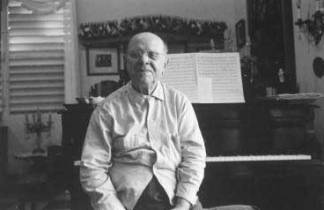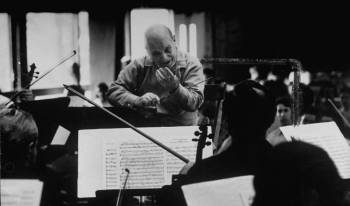
Pau Casals i Defilló (December 29, 1876 – October 22, 1973) The great Spanish cellist (and conductor), Pablo Casals (actually, Pau Carlos Salvador Defilló), legend has it, supported by Casals himself, that he was conceived when Johannes Brahms began his B-flat Major Quartet, of which Casals owned the original manuscript, and that he was born when J. Brahms completed its composition. This legend is rendered moot by the fact that the quartet in question was completed and performed before Casals was even born. But even the ascertainable facts of the life of Casals make it a glorious tale. His father, the parish organist and choirmaster in Vendrell, gave Casals instruction in piano, violin, and organ. When Casals was 11, he first heard the cello performed by a group of traveling musicians, and decided to study the instrument. In 1888 his mother took him to Barcelona, where he enrolled in the Escuela Municipal de Música. There he studied cello with José García, theory with José Rodoreda, and piano with Joaquín Malats and Francisco Costa Llobera. His progress as a cellist was nothing short of prodigious, and he was able to give a solo recital in Barcelona at the age of 14, on February 23, 1891; he graduated with honors in 1893. Albéniz, who heard him play in a cafe trio, gave Pablo Casals a 1etter of introduction to Count Morphy, the private secretary to María Cristina, the Queen Regent, in Madrid. Casals was asked to play at informal concerts in the palace, and was granted a royal stipend for composition study with Tomás Bretón. In 1893 he entered the Conservatory de Musica y Declamacion in Madrid, where he attended chamber music classes of Jesus de Monasterio. He also played in the newly organized Quartet Society there (1894-1895). In 1895 he went to Paris and, deprived of his stipend from Spain, earned a living by playing 2nd cello in the theater orchestra of the Folies Marigny. He decided to return to Spain, where he received, in 1896, an appointment to the faculty of the Escuela Municipal de Música in Barcelona; he was also principal cellist in the orchestra of the Gran Teatro del Liceo. In 1897 he appeared as soloist with the Madrid Symphony Orchestra, and was awarded the Order of Carlos III from the Queen. His career as a cello virtuoso was then assured. In 1899 Pablo Casals played at. the Crystal Palace in London, and later for Queen Victoria at her summer residence at Cowes, Isle of Wight. On November 12, 1899, he appeared as a soloist at a prestigious Lamoureux Concert in Paris, and played with Lamoureux again on December 17, 1899, obtaining exceptional success With both the public and the press. He toured Spain and Holland with the pianist Harold Bauer (1900-1901); then made his first tour of the USA (1901-1902). In 1903 he made a grand tour of South America. On January 15, 1904, he was invited to play at the White House for President Theodore Roosevelt. In 1906 he became associated with the talented young Portuguese cellist Guilhermina Suggia, who studied with him and began to appear in concerts as Mme. P. Casals-Suggia, although they were not legally married. Their liaison was dissolved in 1912; in 1914 Casals married the American socialite and singer Susan Metcalfe; they were separated in 1928, but did not divorce until 1957. Continuing his brilliant career, Pablo Casals organized, in Paris, a concert trio with the piariist Alfred Cortot and the violinist Thibaud; they played concerts together until 1937. Casals also became interested in conducting, and in 1919 he organized, in Barcelona, the Orquesta Pall Casals and led itsftrst concert on October 13, 1920. With the outbreak of the Spanish Civil War in 1936, the Orquesta Pau Casals ceased its activities. Casals was an ardent supporter of the Spanish Republican government, and after its defeat vowed never to return to Spain until democracy was restored. He settled in the French village of Prades, on the Spanish frontier; between 1939 and 1942 he made sporadic appearances as a cellist in the unoccupied zone of southern France and in Switzerland. So fierce was his opposition to the Franco regime in Spain that he declined to appear in countries that recognized the totalitarian Spanish government, making an exception when he took part ill a concert of chamber music in the White House on November 13, 1961, at the invitation of President John F. Kennedy, whom he admired. In 1950 Pablo Casals resumed his career as conductor and cellist at the Prades Festival, organized in commemoration of the bicentennial of the death of J.S. Bach; he continued leading the Prades Festivals until 1966. He made his permanent residence in 1956, when he settled in San Juan, Puerto Rico (his mother was born there when the island was still under Spanish rule). In 1957 an annual Festival Casals was inaugurated there. During all these years, he developed energetic activities as a pedagogue, leading master classes in Switzerland, Italy, Berkeley, California, and Marlboro, Vermount, some of which were televised. Pablo Casals was also a composer; perhaps his most effective work is La sardana, for an ensemble of cellos, which he composed in 1926. His oratorio El pessebre (The Manger) was performed for the first time in Acapulco, Mexico, on December 17, 1960. One of his last compositions was the Himno a las Naciones Unidas (Hymn of the United Nations); he conducted its ftrst performance in a special concert at the United Nations on October 24, 1971, 2 months before his 95th birthday. On August 3, 1957, at the age of 80, Casals married his young pupil Marta Montañez; following his death, she married the pianist Eugene Istomin, on February 15, 1975. Casals did not live to see the liberation of Spain from the Franco dictatorship, but he was posthumously honored by the Spanish government under King Juan Carlos I, which issued in 1976 a commemorative postage stamp in honor of his 100th birthday. ************************

Ludwig van Beethoven Symphony no 1 in C major, Op. 21
Symphony no 2 in D major, Op. 36
Symphony no 6 in F major, Op. 68
Symphony no 7 in A major, Op. 92
1969
Symphony no 8 in F major, Op. 93
1963
Egmont, Op. 84: Overture 1970
Marlboro Festival Orchestra
Pablo Casals
************************
Записи из собственной коллекции.
+ BONUS from Nibelung
Ludwig van Beethoven Symphony no 1 in C Major, op.21
Orkuesta Casals de Barselona
1929
Die Ruinen von Athens, op.113, Overture
Orkuesta Casals de Barselona
1929
Coriolan op.62, Overture
London Symphony Orkestra
1928
Johannes Brahms
Variations on a theme by Joseph Haydn, op.56
London Symphony Orkestra
1928
+ BONUS from skass2007
Ludwig van Beethoven
Symphony no 4 in B flat major, Op. 60 Marlboro Festival Orchestra
1969 Franz Peter Schubert Symphony no 5 in B flat major, Op. 60 Marlboro Festival Orchestra
1970
|

